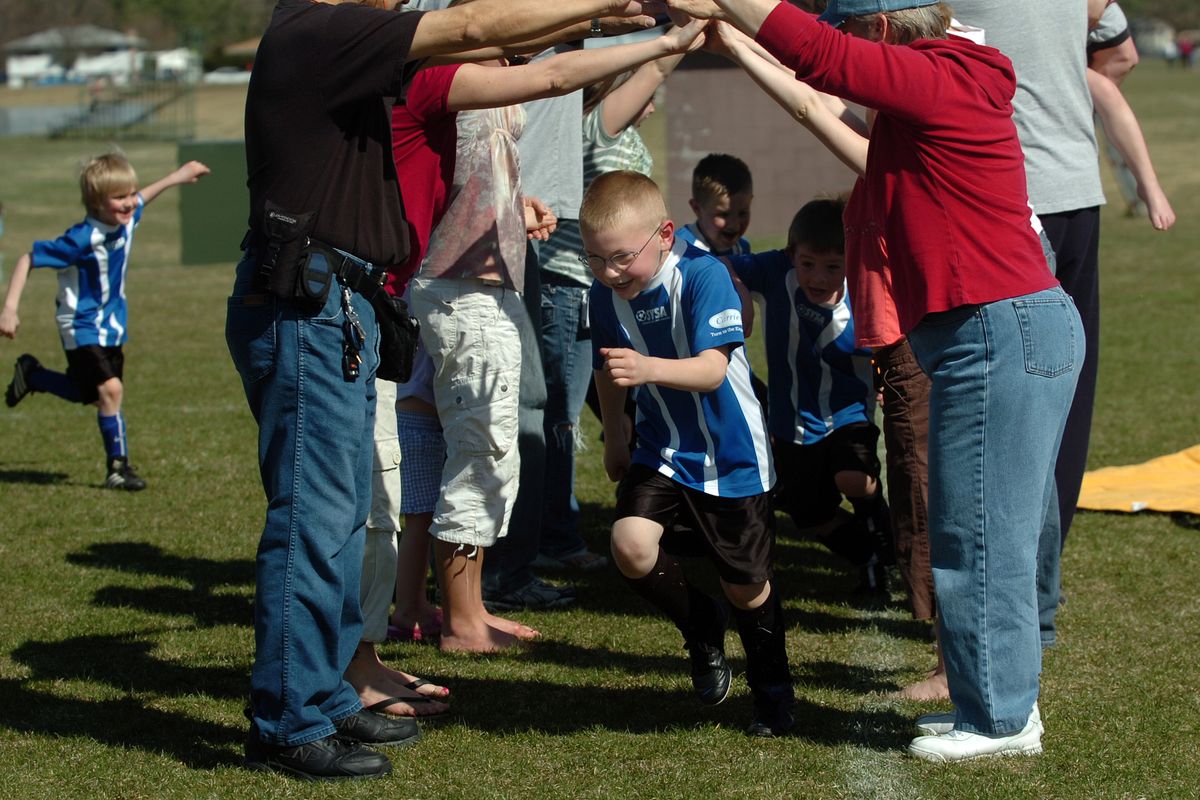Controversial South Hill youth sports complex plan requires clarification, judge rules
C.J. Niska runs out of a tunnel of parents’ arms after a Spokane Youth Sports Association game at Farwell Road field complex in this April 2008 photo. The nonprofit SYSA has plans to build a sports complex with four baseball and two multiuse fields in the rural area of 37th Avenue and Glenrose Road on the upper South Hill. (JESSE TINSLEY)
The head of Spokane County’s planning department must explain why a multiuse youth sports complex can be built in a rural area on Spokane’s upper South Hill, a county judge ruled late last month.
The decision is what neighborhood advocates called a “bittersweet victory” in an ongoing legal battle to prevent construction on historic meadowlands near 37th Avenue and Glenrose Road.
It doesn’t prevent the proposed $2.2 million project from being built by the Spokane Youth Sports Association, but it will create an administrative record that could be challenged in court or used in negotiations, said Rick Eichstaedt, an attorney representing the neighborhood association opposing the construction.
“What this does is, it creates an appealable decision,” Eichstaedt said. “It lets us see if early in the process this issue can be resolved.”
That issue is an interpretation of county zoning codes that would apply to the project, which calls for the construction of four youth baseball fields, two synthetic turf multiuse fields, a basketball court and other amenities.
SYSA filed documents as recently as February to support the project, known as the Zakheim Youth Sports Complex, on 20 acres of undeveloped land on the southeast corner of 37th and Glenrose, and has also obtained $350,000 in state grant funds to build the complex.
A phone message and email to SYSA’s executive director were not returned Tuesday.
The neighborhood association argues the classification the county is using to permit the construction of the project outside Spokane city limits doesn’t match the scope of the project, which intends to bring youth athletes from all areas of the county to the fields for tournament play year-round.
That determination, classifying the project as a “community recreation facility,” was initially made by Spokane County Planning Director John Pederson as part of a previous application to develop the land by Spokane Little League a decade ago.
SYSA bought the land from the youth baseball league in 2016 for $476,000, according to Spokane County Assessor’s Office records.
Pederson declined to comment on that determination in a phone call Tuesday, but said those opposing the project would have opportunities to appeal any official determination or building permit to the county’s hearing examiner.
“There’s a couple different bites at the apple,” Pederson said.
Under the neighborhood’s interpretation, the complex should be classified as a “participant sports and recreation facility,” a category of construction that would not be permitted on its current site.
Residents argue the project will bring traffic to already packed roadways, and overhead lights would disrupt the some 1,500 homes in the area.
Eichstaedt said the neighborhood’s classification made more sense for the scope of the project, as a “community recreation facility” is defined in the code as a building or area built for recreation “for persons within the area in which it is located and not operated for profit.” By comparison, the sports facility classification includes projects where “sport or recreation is conducted outside an enclosed structure.”
SYSA is a tax-exempt, nonprofit organization recognized by the IRS.
“Neither one of these definitions is defined well,” Eichstaedt said, but other examples of community recreation facilities in the county included things like private clubhouses, not ballfields, he said.
The neighborhood association sued in November to compel Pederson to provide a written explanation for his reasoning. Spokane County Superior Court Judge Julie McKay granted that request at a hearing June 26, but has yet to sign a formal order requiring it.
Eichstaedt said the county’s code required a written determination within 30 days of a judge’s decision.
SYSA is also operating under a timetable, per the terms of their agreement with the Washington Recreation and Conservation Office. The $350,000 awarded in 2018 is intended to be used to build the first of the two multiuse fields on the site. According to the terms of the grant agreement, that project must be finished by Aug. 31, 2021.

